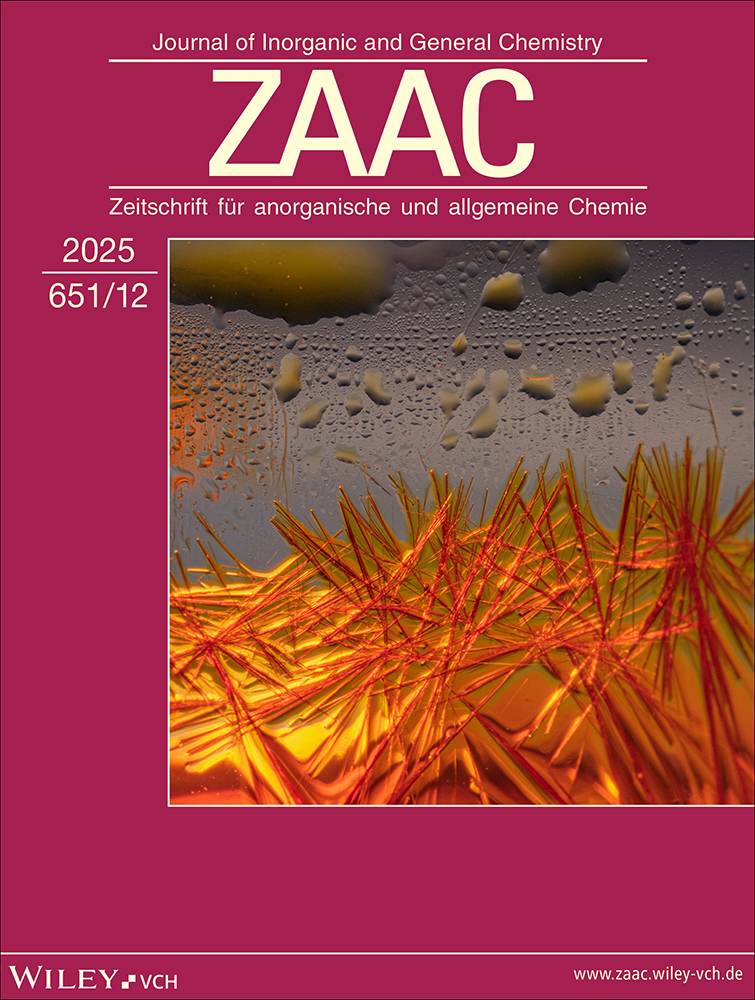Synthese und Struktur von [(Me2PhP)3Cl2ReN]2ReCl4, [(Me2PhP)3Cl2ReN]2ReCl4 · 2 SbCl3 und [Re(NH)Cl2(PMe2Ph)3][SbCl6]
Abstract
deDie Reaktion von ReNCl2(PMePh)3 mit SbCl5 in Toluol ergibt den Dreikernkomplex [(Me2PhP)3Cl2Re≡N]2ReCl4 · 2 SbCl3 (1 · 2 SbCl3). Er bildet sowohl trikline Kristalle der Zusammensetzung 1 · 2 SbCl3 als auch solvathaltige, monokline Kristalle der Zusammensetzung 1 · 2 SbCl3 · 4 C7H8. Letztere wurden einer Kristallstrukturanalyse zugrundegelegt (P21/c, a = 1212,3(2); b = 2098,5(4); c = 1827,7(3) pm; β = 95,51(1)°; Z = 2). Im zentrosymmetrischen Komplex 1 koordinieren zwei Komplexe ReNCl2(PMe2Ph)3 mit ihren Nitridoliganden eine zentrale, quadratisch-planare Baugruppe ReCl4. Die SbCl3-Moleküle sind über Chlorobrücken an Cl-Atome von 1 koordiniert und verbrücken zugleich die Komplexe 1 untereinander. Die SbCl3-freie Verbindung 1 wird in guter Ausbeute bei der Umsetzung von ReNCl2(PMe2Ph)3 mit ReCl4(NCEt)2 erhalten. Sie kristallisiert triklin in der Raumgruppe P1 mit a = 1037,7(3); b = 1153,0(2); c = 1393,8(3) pm; α = 72,31(2)°; β = 74,06(2)°; γ = 67,94(2)° und Z = 1. Die Bindungslänge der Re–N-Dreifachbindung beträgt in 1 172 pm und in 1 · 2 SbCl3 170 pm.
Bei der Umsetzung von ReNCl2(PMe2Ph)3 mit SbCl5 in CH2Cl2 wird vom Lösungsmittel HCl abgespalten, das den Nitridoliganden unter Bildung des Imidokomplexes [Re(NH)Cl2(PMe2Ph)3][SbCl6] (2) protoniert. 2 bildet monokline Kristalle mit der Raumgruppe P21/n und a = 1221,4(2); b = 1358,6(2); c = 2177,3(1) pm; β = 92,72(1)° und Z = 4. Der Re–N-Abstand in der nahezu linearen Baugruppe Re≡N–H beträgt 169,1 pm.
Abstract
enSynthesis and Structure of [(Me2PhP)3Cl2ReN]2ReCl4, [(Me2PhP)3Cl2ReN]2ReCl4 · 2 SbCl3 and [Re(NH)Cl2(PMe2Ph)3][SbCl6]
The reaction of ReNCl2(PMePh)3 with SbCl5 in toluene yields the trinuclear complex [(Me2PhP)3Cl2Re≡N]2ReCl4 · 2 SbCl3 (1 · 2 SbCl3). It forms triclinic crystals with the composition 1 · 2 SbCl3, as well as monoclinic crystals 1 · 2 SbCl3 · 4 C7H8. The monoclinic crystals with the space group P21/c, and a = 1212.3(2), b = 2098.5(4), c = 1827.7(3) pm, β = 95.51(1)°, Z = 2, have been used for a crystal structure determination. In the centrosymmetric complex 1 two complexes ReNCl2(PMe2Ph)3 coordinate with their nitrido ligands a square planar, central unit ReCl4. The SbCl3 molecules are coordinated by chlorine bridges to Cl atoms of 1, and, in addition, connect the complexes 1 with each other. The SbCl3 free compound 1 is obtained in good yield by the reaction of ReNCl2(PMePh)3 with ReCl4(NCEt)2. It crystallizes in the triclinic space group P1 with a = 1037.7(3), b = 1153.0(2), c = 1393.8(3) pm, α = 72.31(2)°, β = 74.06(2)°, γ = 67.94(2)°, and Z = 1. The bond lengths of the Re–N triple bonds are 172 pm in 1 and 170 pm in 1 · 2 SbCl3.
By the reaction of ReNCl2(PMePh)3 with SbCl5 in CH2Cl2 the solvent is decomposed forming HCl which protonates the nitrido ligand to afford the imido complex [Re(NH)Cl2(PMe2Ph)3][SbCl6] (2) crystallizing in the monoclinic space group P21/n with a = 1221.4(2), b = 1358.6(2), c = 2177.3(1) pm, β = 92,72(1)° and Z = 4. The Re–N distance in the almost linear unit Re≡N–H is 169,1 pm.




